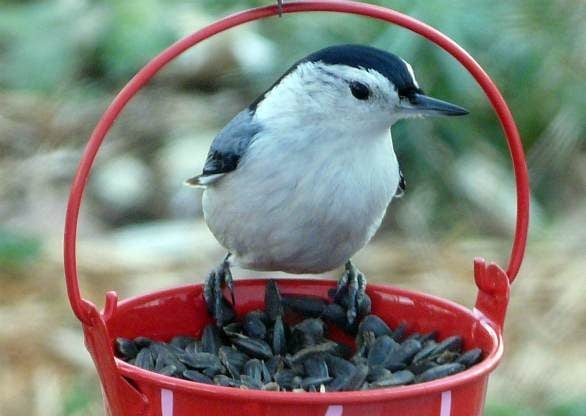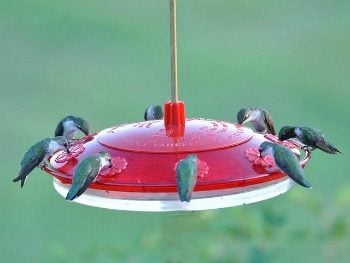Best Birdseed to Feed Backyard Birds
Updated: Apr. 24, 2020

Choose these seeds to attract and feed your favorite birds.
Sunflower Seed: This is at the top of the list of all seed for feeding birds. If you want to rely on just one type of seed that is most attractive to the greatest number of backyard birds, hands down sunflower seed is the right pick in any form—in the shell (black oil or white striped) or medium cracked out-of-the-shell meats. All forms of sunflower seeds are relished by finches, chickadees, nuthatches, grosbeaks, cardinals, jays and even some species of woodpeckers.
There’s only one problem with sunflower seed—bully birds, such as blackbirds, European starlings and grackles, also love it, especially if it’s served in a tray feeder.
There’s a simple solution. Serve sunflower seeds from a feeder that allows only the smaller birds to enter the feeding chamber. These feeders are often called “exclusion feeders,” with smaller perches, weight mechanisms or fencing to keep the larger birds out.
Nyjer Seed (Thistle): If finches are your fancy, like the brilliant-yellow American goldfinches that frequent my area, then you’ll want to serve up this tiny black seed some people call thistle. It’s best served in a special tube feeder that has very tiny ports to keep the small seeds from pouring out.
Chickadees love nyjer seed, too, and their acrobatic behavior allows them to extract the seeds from the tiny food ports. It’s also a good choice if you’re overrun by larger bully birds. They have a problem feeding from the tiny ports.

Sugar Water: During spring and summer, sugar water mixed in the kitchen (one part sugar to four parts water, boil and cool before serving) is dynamite for feeding birds like hummingbirds and orioles. Because most hummingbird feeders are made of red plastic, and oriole feeders of orange plastic, the sugar water doesn’t even need to be colored to attract the birds’ attention. Once these desirable birds find the feeder, it will be a challenge keeping it filled.
Suet Cakes: One of my pet peeves is the commercial suet cake selection in bird stores. Most suet cakes contain a smorgasbord of foods other than suet, such as berries, oranges and even insects. The most common extra ingredient in suet cakes is birdseed. Birds that eat suet, including woodpeckers, nuthatches, chickadees and titmice, eat it to get the energy that the suet offers, so all the extras are virtually useless. If they require seeds, berries or insects, they’ll find those food items elsewhere.
For my backyard, I purchase only pure suet cakes.
Safflower Seeds: Though it may take some birds a little time to get acquainted with safflower seeds, cardinals, grosbeaks, mourning doves and house finches will frequent feeders serving it. Because northern cardinals prefer a flat surface to stand on when eating, a tray feeder or hopper feeder with a wide rim makes it easier for them to eat safflower seed. Even chickadees will remove a single safflower seed and fly to a nearby branch to crack it open.
Perhaps best of all, squirrels don’t like safflower seed! Consider switching to it if you’re pestered by these furry rascals.
Wild Birdseed Mixes: This is often the “mystery mix” you’ll find at grocery stores or on sale at the local discount store. It’s usually a mix of lots of millet, cracked corn and very few sunflower seeds. The basic problem with these feed-all mixes is that they’re not discriminating and may attract mostly undesirable birds and night critters, such as rats and raccoons. I recommend avoiding these do-all mixes, and stick with the specialty foods listed.
Feeding the most desired birds is probably much easier than you thought. Order off the right menu and you’re likely to see the birds you want feasting right outside your favorite picture window.
Feeders Hold More Than FoodThere’s more to filling feeders with the right seed to attract the birds you want. A feeder’s shape, placement in the yard and distance above the ground will determine what kinds of birds actually use it. And yes, proper cover and habitat play an equally important role.
Here’s a quick rundown of the most effective bird feeders:
Tray feeders, on a post or hanging, are open pantry shelves that attract most seed-eating birds. Problem is they also attract rain, snow and ice, so you have to maintain them more than other feeders.
Certain birds, such as cardinals, grosbeaks, bluebirds, woodpeckers and robins, will basically feed from only these types of feeders. Try to get one with screening or holes in the bottom for drainage to keep seed from spoiling.
Tube feeders are hanging cylinders with portholes and perches that are favored by small finches. Chickadees and nuthatches will use them, too.
If the bully birds figure out how to eat from a tube feeder, you may want to shorten the perches slightly, or enclose the feeder in a wire mesh that will allow only the little birds to get to the food. Commercially made exclusion feeders are available.
Hopper feeders, either on a post or hanging, are targeted to most kinds of seed-eating birds. They usually have an enclosed reservoir for seeds that slides food down to the open feeding tray below. The advantage is that the hopper keeps the seeds dry and always available to birds.
Suet feeders are usually small square laminated cages that hold blocks of suet. They can hang on a tree trunk or be suspended from a branch. They’re great for attracting woodpeckers, as well as titmice, chickadees and nuthatches.
Sugar-water feeders are for hummingbirds and orioles. Tanagers, finches and other birds may also use them. Simply keep them topped off with fresh homemade sugar water…and stand back.
